Just when we, as a society, begin to think we are making headway with social justice and tolerance, we are reminded of how much more there is to do. Young adult authors take this challenge seriously and continue writing thought-provoking fiction and nonfiction to offer contemporary adolescents a view of past struggles. The National Book Awards provided the impetus for this project when the 2014 Longlist for Young People’s Literature included Steve Sheinkin’s The Port Chicago 50: Disaster, Mutiny, and the Fight for Civil Rights and Deborah Wiles’ Revolution: The Sixties Trilogy, Book Two while Jacqueline Woodson’s Brown Girl Dreaming won the award. We wondered what choices teachers have from recently published works to help them blend civil rights into literacy instruction. Here are the texts and ideas we came up with.
Stella by Starlight (Simon & Schuster, 2015)
by Sharon M. Draper
Ages 9-12
Historical Fiction
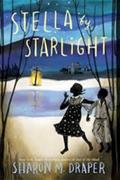 Young Stella chronicles her dreams of reading in a library, improving her writing, and living in an equitable world when she sneaks out of the house to write in her journal under the starlight. For a young African-American girl in rural, segregated South Carolina in 1932, these simple dreams sometimes seemed out of reach. Stella chronicles experiences and challenges of growing up, racism, and prejudice. She is profoundly impacted by her community’s encounters with the Ku Klux Klan and segregated classrooms that only receiv out-of-date worn books the white schools no longer want. In Stella by Starlight, Stella’s indomitable spirit and optimism shine through, taking the reader beyond challenges to a place of hope.
Young Stella chronicles her dreams of reading in a library, improving her writing, and living in an equitable world when she sneaks out of the house to write in her journal under the starlight. For a young African-American girl in rural, segregated South Carolina in 1932, these simple dreams sometimes seemed out of reach. Stella chronicles experiences and challenges of growing up, racism, and prejudice. She is profoundly impacted by her community’s encounters with the Ku Klux Klan and segregated classrooms that only receiv out-of-date worn books the white schools no longer want. In Stella by Starlight, Stella’s indomitable spirit and optimism shine through, taking the reader beyond challenges to a place of hope.
Teaching Ideas
Discussion: When Stella’s father asks her to come with him on the day he goes to vote in the presidential election, he indicates that Stella is his “standing stone.” What does her father mean by this reference? What does his reference indicate about Stella’s character and about her relationship with her father? What does her father’s reference to the need for a “standing stone” indicate about the situation he is likely to encounter as he goes to vote?
Writing project: Direct students to consider supportive people in their own lives. Identify one of those people they would consider a “standing stone.” Have students write several specific reasons why they consider that person a standing stone. Direct students to include a detailed narrative about a situation in which the selected person offered support and gave strength through a difficult situation. If a student feels as though s/he does not have a person to depend on, have the student write some of the qualities s/he would look for in a standing stone. All students should then write about how they can be a standing stone for another person in a difficult situation.
The Port Chicago 50: Disaster, Mutiny, and the Fight for Civil Rights (Roaring Brook Press, 2014)
by Steve Sheinkin
Ages 10-14
Non-Fiction
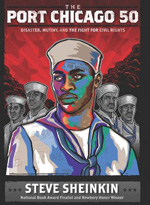 The story of 50 courageous men who stood on the frontline of the civil rights movement is chronicled in The Port Chicago 50: Disaster, Mutiny, and the Fight for Civil Rights. Only the African-American service members in the highly segregated U.S. Navy during World War II were required to load deadly ammunition and live bombs onto cramped ships at the Port Chicago base. After a deadly explosion that killed 320 servicemen and injured many more, the African American sailors demanded safer working conditions before they would load the ships with explosives again. The Navy classified this resistance as mutiny, and threatened the African-American sailors with death by firing squad if they did not comply with orders. Some of the men backed down, but 50 did not. This historical narrative recounts the painful Port Chicago disaster and ensuing controversial court-martial of 50 African American service members after the incident. The book is built on painstaking research of the facts, and is made richer still with the narrative of many of the men who experienced the incident. Images of original photos and documents throughout the book make this non-fiction text extraordinarily insightful and approachable for adolescent readers.
The story of 50 courageous men who stood on the frontline of the civil rights movement is chronicled in The Port Chicago 50: Disaster, Mutiny, and the Fight for Civil Rights. Only the African-American service members in the highly segregated U.S. Navy during World War II were required to load deadly ammunition and live bombs onto cramped ships at the Port Chicago base. After a deadly explosion that killed 320 servicemen and injured many more, the African American sailors demanded safer working conditions before they would load the ships with explosives again. The Navy classified this resistance as mutiny, and threatened the African-American sailors with death by firing squad if they did not comply with orders. Some of the men backed down, but 50 did not. This historical narrative recounts the painful Port Chicago disaster and ensuing controversial court-martial of 50 African American service members after the incident. The book is built on painstaking research of the facts, and is made richer still with the narrative of many of the men who experienced the incident. Images of original photos and documents throughout the book make this non-fiction text extraordinarily insightful and approachable for adolescent readers.
Teaching Ideas:
The epilogue offers an excerpt from the Navy’s official 1994 report of the Port Chicago incident stated although racial discrimination was institutionalized by segregated working and living conditions, “…racial prejudice and discrimination played no part in the court-martial convictions or sentences, and that there was nothing unfair or unjust in the final outcome of any of the Port Chicago court-martials.” Instruct students to consider the following question: Do you agree or disagree with this statement, and why? As students write their answers, they should include at least five references to evidence in the text to support their opinion. This writing activity could be used as an informal planning session to organize for a thoughtful classroom debate or as a planning activity prior to writing an essay after reading The Port Chicago 50.
Ask students to research a contemporary issue that involves civil rights issues. Each student will then compose a persuasive letter to a newspaper editorial page or blog like The Huffington Post stating a stance on the issue. The op-ed piece must be supported by the research.
Brown Girl Dreaming (Nancy Paulsen Books, 2014)
by Jacqueline Woodson
Ages 10+
Non-Fiction Novel-in-Verse
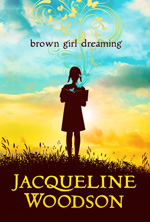 Jacqueline Woodson does not disappoint in her National Book Award-winning novel-in-verse Brown Girl Dreaming. She eloquently weaves a story of how who she was has made her into the woman she is today. Memories paint a picture of what her family means to her as well as her idea of home, which while it changes its physical location several times, stays the same in her heart. Through Woodson’s words we can see a child’s understanding of history as she moves from Ohio where being colored does not define her, to South Carolina where she must quickly learn to sit at the back of the bus and refrain from making eye contact with white people during the Civil Rights movement. Adolescent readers will benefit not only from the historical context in which the book is set, but also by the author’s examination of home, family, freedom, and sense of self. Teens are on a journey of self-discovery, and this novel poetically shows them someone else’s moments of impact as well as their effects.
Jacqueline Woodson does not disappoint in her National Book Award-winning novel-in-verse Brown Girl Dreaming. She eloquently weaves a story of how who she was has made her into the woman she is today. Memories paint a picture of what her family means to her as well as her idea of home, which while it changes its physical location several times, stays the same in her heart. Through Woodson’s words we can see a child’s understanding of history as she moves from Ohio where being colored does not define her, to South Carolina where she must quickly learn to sit at the back of the bus and refrain from making eye contact with white people during the Civil Rights movement. Adolescent readers will benefit not only from the historical context in which the book is set, but also by the author’s examination of home, family, freedom, and sense of self. Teens are on a journey of self-discovery, and this novel poetically shows them someone else’s moments of impact as well as their effects.
Teaching Ideas
Free verse is a form that allows more freedom than other types of writing, so it is hopefully one that adolescents will be comfortable using. The last two poems, “what i believe,” and “each world” sum up what Woodson has learned through the parts of her life that she shared with us in the novel. Students could be asked to produce a free verse poem that sums up what they believe after they are guided through the process of examining important things in their lives. As the students read the novel, have them journal on certain selected poems from the book making sure that it is a reflection on their own lives. For example, “other people’s memory” on page 17 would require them to talk to different members of their family about their birth and construct their own story of their birth to tell. In “as a child, I smelled the air” on page 95, students would have to examine sights, smells, and sounds of important places in their lives. Page 131 offers a poem entitled “sometimes, no words are needed,” which would guide students to think about such a moment in their own lives. Woodson demonstrates how she modeled a poem off of a Langston Hughes poem in “learning from langston” on page 245. Instruct students to pick one of their favorite poems and following the style of that poet, write their own stanza about the same subject from their own perspective. As their assessment for this unit, have them write their own free verse poem about what they currently believe about themselves and life.
The Fog Machine (Lucky Sky Press, 2014)
by Susan Follett
General Audience
Historical Fiction
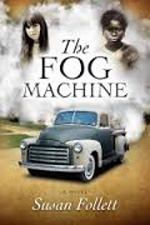 Joan from Follett’s The Fog Machine examines a bookcase in one of the freedom summer schools that was set up in Mississippi in 1964. “Reading would be no fun at all, she thought, if you couldn’t imagine yourself into the story.” Follett manages in this beautiful tale to not only pull readers in and imagine themselves in the story, but she also forces them to question how they would behave during interactions that occur throughout the novel. The Fog Machine is a poignant tale of a search for equality and justice by different people during the time of the Civil Rights movement. Told from the points of view of C.J. who is a colored girl of 12 years old at the beginning of the novel, as well as sometimes from Joan, the little white girl that C.J. cared for at one point in her life, and Zach, a white boy C.J.’s age who impacts her in ways she could never have predicted, we see the varying perspectives of both races during the tumultuous times in the late 1950’s and early 1960’s. We watch the characters grow up separately and interact with people that will help them to shape their own beliefs of what is right and how people should be treated. All of them will be forced to leave their comfort zones as they ultimately decide how hard they are willing to fight for freedom and whether or not the price is worth it. Lives separate and then intersect again throughout the novel leaving the reader with a sense of connectedness between the characters that the time in which they live attempts to destroy. It is a realistic story that breaks the reader’s heart at times with its truth, leaving one to ponder how things could have turned out differently for the characters at a later time in history.
Joan from Follett’s The Fog Machine examines a bookcase in one of the freedom summer schools that was set up in Mississippi in 1964. “Reading would be no fun at all, she thought, if you couldn’t imagine yourself into the story.” Follett manages in this beautiful tale to not only pull readers in and imagine themselves in the story, but she also forces them to question how they would behave during interactions that occur throughout the novel. The Fog Machine is a poignant tale of a search for equality and justice by different people during the time of the Civil Rights movement. Told from the points of view of C.J. who is a colored girl of 12 years old at the beginning of the novel, as well as sometimes from Joan, the little white girl that C.J. cared for at one point in her life, and Zach, a white boy C.J.’s age who impacts her in ways she could never have predicted, we see the varying perspectives of both races during the tumultuous times in the late 1950’s and early 1960’s. We watch the characters grow up separately and interact with people that will help them to shape their own beliefs of what is right and how people should be treated. All of them will be forced to leave their comfort zones as they ultimately decide how hard they are willing to fight for freedom and whether or not the price is worth it. Lives separate and then intersect again throughout the novel leaving the reader with a sense of connectedness between the characters that the time in which they live attempts to destroy. It is a realistic story that breaks the reader’s heart at times with its truth, leaving one to ponder how things could have turned out differently for the characters at a later time in history.
Teaching Ideas
There is a historic timeline in the front of the book that is helpful for students to cross-reference events as they happen in the story, but also serves as a topic list for potential group projects. Have students pick an event from the list and ask them to research more about that particular topic. Students can have control over how they present the information they learn to the class, but they must be sure to also reference how the characters in the book felt, or what they did in reaction to the event or topic that the group has researched. They must also individually write a reflection on how they personally feel about the event or person now, and what they imagine they would have done if they were living in those times. As groups present their topics, all students should take notes so that at the end of the presentations each individual will turn in a completed timeline of events that were discussed, with three main points about each thing included.
The Freedom Summer Murders (Scholastic, 2014)
by Don Mitchell
Ages 14+
Non-Fiction
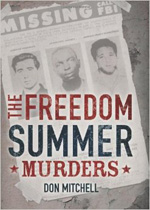 Andrew Goodman, James Earl Chaney, and Michael “Mickey” Schwerner were household names in Freedom Summer 1964 because of their gruesome deaths that were covered up by law enforcement in Neshoba County, Mississippi. The Freedom Summer Murders is a non-fiction look at these three gentlemen; who they were and what they stood for, as well as the story of their brutal murders followed by a look at the investigation into first finding their bodies, and then attempting to prosecute the guilty parties. The black and white pictures serve to enhance the story, and many highlight the racial tensions of the time. Students who read this book will come away with a better understanding of what was at stake for African Americans during this tumultuous time, as well as the risks that the freedom workers –black and white- took together in an effort to fight for civil rights. This book would work well paired with The Fog Machine, since the disappearance of these three young men was discussed in that work of fiction. There were some volunteers in that book who knew one or more of the men, and it was certainly an event that overshadowed the work of the characters during Freedom Summer.
Andrew Goodman, James Earl Chaney, and Michael “Mickey” Schwerner were household names in Freedom Summer 1964 because of their gruesome deaths that were covered up by law enforcement in Neshoba County, Mississippi. The Freedom Summer Murders is a non-fiction look at these three gentlemen; who they were and what they stood for, as well as the story of their brutal murders followed by a look at the investigation into first finding their bodies, and then attempting to prosecute the guilty parties. The black and white pictures serve to enhance the story, and many highlight the racial tensions of the time. Students who read this book will come away with a better understanding of what was at stake for African Americans during this tumultuous time, as well as the risks that the freedom workers –black and white- took together in an effort to fight for civil rights. This book would work well paired with The Fog Machine, since the disappearance of these three young men was discussed in that work of fiction. There were some volunteers in that book who knew one or more of the men, and it was certainly an event that overshadowed the work of the characters during Freedom Summer.
Teaching Ideas
As a pre-reading activity, display a few of the pictures found in The Freedom Summer Murders without the captions on an Elmo, such as the ones on page 105, 109, and pg. 145. Instruct the students to journal about what they think is going on in these pictures. Tell them that they will see these photos again as they read the book. As they come across each picture while reading, have them journal about each photo again now that they understand the context of the photo. Break the students into small groups and assign each group one of the pictures. Instruct them to create a t-chart of their reaction to the photo when it was taken out of context, and then their reaction as they came across it while reading and understood what was really going on in the pictures. Have each group share with the class and ask them to discuss how their reactions changed to the photos once the background on each was discovered.
Countdown (Scholastic, 2013) and
Revolution (Scholastic, 2014)
by Deborah Wiles
Ages 8-12
Historical Fiction
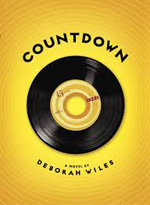 These companion texts are part of a trilogy set in the turbulent Sixties; each features a young teen girl growing up amid a tumultuous and changing world, one she often does not understand. In Countdown, Franny Chapman is 11 and living with her family near Washington, DC, in Camp Springs, Maryland, during the 1962 Cuban Missile Crisis. The threat of nuclear war is not just for world leaders, but becomes very real for Franny and her family. Her younger brother annoys her since he always behaves himself. Her older sister Jo Ellen gets caught up in mysterious, secret meetings on campus at the University of Maryland. Her dad is in the Air Force and gets calls to report to base more frequently than he should while her mother tries to hold it all together. Uncle Otts, a World War I veteran, is determined to build a bomb shelter in their front yard. Amidst this turmoil, Franny is losing her best friend and perhaps gaining a boyfriend and trying her best to grow up no matter what is going on.
These companion texts are part of a trilogy set in the turbulent Sixties; each features a young teen girl growing up amid a tumultuous and changing world, one she often does not understand. In Countdown, Franny Chapman is 11 and living with her family near Washington, DC, in Camp Springs, Maryland, during the 1962 Cuban Missile Crisis. The threat of nuclear war is not just for world leaders, but becomes very real for Franny and her family. Her younger brother annoys her since he always behaves himself. Her older sister Jo Ellen gets caught up in mysterious, secret meetings on campus at the University of Maryland. Her dad is in the Air Force and gets calls to report to base more frequently than he should while her mother tries to hold it all together. Uncle Otts, a World War I veteran, is determined to build a bomb shelter in their front yard. Amidst this turmoil, Franny is losing her best friend and perhaps gaining a boyfriend and trying her best to grow up no matter what is going on.
What makes both of these books remarkable, however, is Wiles’ documentary novel approach. Pop songs of the era, along with Red Scare reminders, overlay powerful images from that time period. Interspersed with the narrative are accounts of those who influenced our society. In Revolution, protest songs and poems are also embedded with the disturbing photos and memorabilia.
In the second book, the scene shifts to Greenwood, Mississippi, and the summer of 1964. Sunny Fairchild is 12, and she and her family, along with the community, prepare for the “invaders.” Freedom Summer is coming bringing the outsiders who will try to register Negroes to vote. As the tension builds in the community, Sunny tries to cope with a new family now that her father has remarried. Annabelle, who is pregnant, her son Gillette and little sister Audrey hope to fit into Sunny’s life, but she resists with everything she has. The tie-in between the two storylines is Jo Ellen Chapman who comes to Greenwood with SNCC, Student Nonviolent Coordinating Committee, to help register voters.
Teaching Ideas
Have students select a song that reflects the times they live in. Prepare a collage using the lyrics of the song along with pictures from magazines and the Internet to explain the theme of the song. Each student should write a brief explanation of how the lyrics and photos suggest the theme the student has chosen. Alternatively, students could work in pairs for a team approach.
The author David Levithan, who used bleak photographs as the backdrop for his book Every You, Every Me (2011), advised Deborah Wiles on the juxtaposition of images and words when writing a novel. Students can create their own documentary novels by using original photographs and tying them together with a story line. Sharing can be done via PowerPoint, Prezi, and even easel paper storyboards.
Do these work for you? Do you have your own methods of including this type of historical fiction or nonfiction? Share your stories at social@reading or on Twitter at
@iratoday.
Judith A. Hayn, is professor of Secondary Education at the University of Arkansas at Little Rock. She is a member and past chair of SIGNAL, the Special Interest Group Network on Adolescent Literature of IRA which focuses on using young adult literature in the classroom. Karina Clemmons, associate professor of Secondary Education, and students in the Masters in Secondary English Education program and Heather A. Olvey is a graduate assistant.